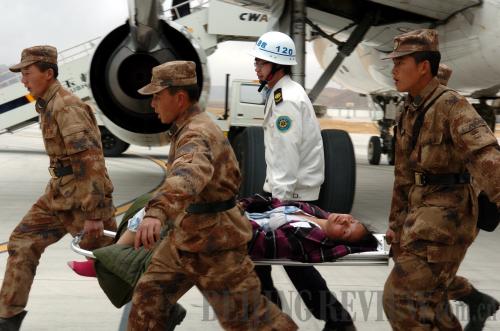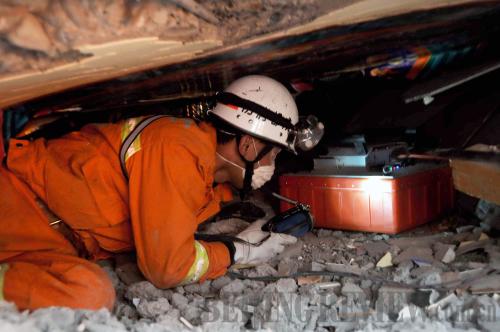|
 |
|
GOING TO LIFE: An injured survivor from the Yushu earthquake is brought to the awaiting relief airplane by soldiers on April 17 (GUO GANG) |
In a remote village more than 20 km from Gyegu Town, the administrative center of Yushu Tibetan Autonomous Prefecture, Qinghai Province, two survivors were pulled alive from the rubbles by rescuers from Sichuan Province on April 19.
According to the rescuers, the 4-year-old girl and her 68-year-old grandmother had been trapped for 123 hours after a 7.1-magnitude earthquake struck the prefecture on April 14.
As of April 21, the quake had left 2,183 people dead, 84 missing and 12,135 injured, of whom 1,434 were in serious condition.
Meanwhile, another Tibetan woman was rescued on April 19 after being trapped for more than 130 hours, China Central Television reported.
Rescuers in quake-hit Yushu had saved more than 17,000 trapped people, said Miao Chonggang, Vice Director of the Quake Relief and Emergency Response Department of the China Earthquake Administration, on April 18.
He said more than 15,000 rescuers, including 1,500 earthquake and mine specialists, are still searching for survivors in Yushu.
A main force
 |
|
HOLDING HOPES: A firefighter uses a life-detection device to scour the rubbles of a collapsed building in the quake-hit Yushu, Qinghai Province, on April 18 (XIAO HONGHUAN) | More than 12,800 rescuers from the People's Liberation Army (PLA) and the People's Armed Police Force (PAPF) had been deployed to the quake zone, China National Radio reported on April 21, quoting Huang Xueping, Director of the Press Information Office of the Ministry of National Defense.
He said that military rescuers had been a substantial force in the quake relief campaign.
Thirteen medical teams and 89 quake-relief aircraft from the PLA and armed police had been dispatched to the quake zone, Huang said on April 21, adding that rescuers from the military and armed police had also transported 5,200 tons of tents, food and other relief materials to Yushu.
The country's armed forces were quick to engage in the earthquake relief work in Yushu, said Wang Zhenguo, chief coordinator with the Yushu quake-relief headquarters of the PLA and the PAPF, at a press conference held by the State Council on April 20 in Beijing.
He said that most of them arrived in Yushu within 30 hours of the quake hitting.
The first professional military rescue team set off from the PLA's Lanzhou Military Command about two hours after the quake.
According to Wang, the Lanzhou Military Command received the order for quake relief deployment from the Central Military Commission and the PLA's General Staff Department in the morning of the deadly quake.
In addition, the Lanzhou Military Command, which directs the PLA's troops in Qinghai Province, also arranged for military units garrisoned near Yushu to join the relief effort.
Tian Yixiang, Director of the Emergency Response Office of the General Staff Department of the PLA, said that such a quick military response was partly due to smooth communication between the General Staff Department and the earthquake authorities.
"The General Staff Department received a report on the quake in Yushu within 12 minutes after the disaster occurred," Tian said.
Nearly two years ago, thousands of military troops who were sent to the quake-hit area in Wenchuan, Sichuan Province, after an 8.0-magnitude earthquake struck, were stranded and blocked by the disrupted traffic. The arrival of rescuers and heavy equipment was also delayed because of air transport problems.
According to Tian, the height of the Yushu quake zone averages 4,000 meters above sea level, and lack of transport facilities was one of the biggest challenges to the rescue and relief efforts.
"Compared with the situation surrounding the Wenchuan earthquake, Yushu is located on the Qinghai-Tibet Plateau and is affected by cold weather. There is no railway and only one airport in Yushu," he said.
The plateau airport, which is approximately 30 km from Gyegu and at 3,900 meters above sea level, is China's airport with the third highest elevation after Qamdo and Lhasa in Tibet. It was only opened last August and could not operate at night.
In order to guarantee the smooth operation of the airport at night, the PLA Air Force installed an emergency airfield lighting system immediately following the earthquake and dispatched its best pilots, said Zheng Yuanlin, an officer with the PLA Air Force. Consequently, the airport's opening time has been extended from 13 hours previously to the whole day.
Additionally, all quake-relief soldiers and armed police had suffered to some extent from altitude sickness, whose symptoms include dizziness, shortness of breath, fatigue, and in worst case situations, could lead to coma, Wang said.
| 